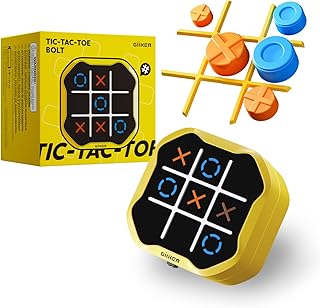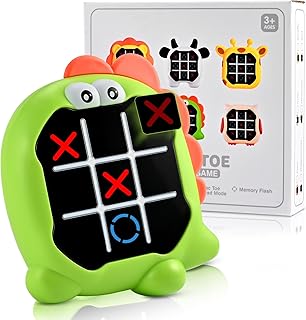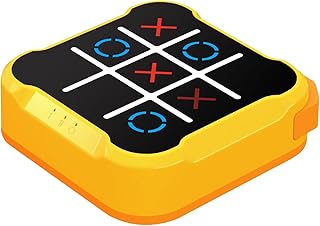The Electronic XO (Tic-Tac-Toe) Game is a digital, often handheld, version of the classic paper-and-pencil game. It translates the simple mechanics of "Noughts and Crosses" into a self-contained electronic unit, typically featuring an LED or LCD screen, button-based input, and a computer-controlled opponent.
Core Concept and Historical Context
The Original Game: Tic-Tac-Toe is a two-player game played on a 3x3 grid. Players take turns marking a square with their symbol, either an 'X' or an 'O'. The first player to get three of their marks in a row (horizontally, vertically, or diagonally) wins. If all nine squares are filled without a winner, the game is a draw.
The Electronic Evolution: In the late 1970s and 1980s, with the advent of affordable microprocessors and simple display technologies, toy manufacturers created dedicated electronic games. Tic-Tac-Toe was a perfect candidate for this transition because its rules are simple to program and its gameplay is universally understood. These devices were among the first to offer a portable, "always available" AI opponent.
Key Components and Hardware
A typical electronic Tic-Tac-Toe unit consists of:
The Game Board (Input/Output Interface):
Display: Early models used a 9-segment LED array (often red), where each of the nine squares was a single LED that could light up as an 'X', an 'O', or remain off. Later and more modern versions use a low-resolution LCD screen that can display the grid, the symbols, and sometimes simple animations or text.
Input Buttons: The primary method of play. This usually involves:
9 Grid Buttons: Each corresponding to a square on the 3x3 grid. The player presses the button where they want to place their mark.
Control Buttons: Buttons for ON/OFF, NEW GAME, RESET, and sometimes to select difficulty levels or switch between playing as 'X' or 'O'.
The "Brain" (Microcontroller):
A single, integrated chip contains the microprocessor, memory (ROM for the game's program, and a small amount of RAM for game state), and input/output controllers.
This chip is pre-programmed with the game's logic, including the AI for the computer's moves.
Power Source:
Typically powered by small button-cell batteries or AAA batteries, making it highly portable.
Casing:
A durable plastic shell designed to be held comfortably in the hands, reminiscent of early handheld gaming devices.
The Software and AI: The Heart of the Game
The programming of the electronic Tic-Tac-Toe game is what brings it to life. The AI's sophistication can vary, but it is typically designed to be unbeatable.
Game Logic:
The program manages the game state: tracking which squares are occupied by 'X', 'O', or are empty.
After every move (both player and computer), it checks all eight possible winning lines (three rows, three columns, two diagonals) to see if a player has won.
It also checks for a draw (a "cat's game") when the board is full with no winner.
The Artificial Intelligence (AI):
Perfect Play: Tic-Tac-Toe is a "solved game." This means the perfect sequence of moves for every possible situation is known. A well-programmed electronic game uses this minimax algorithm—a decision-making rule that minimizes the player's chance of winning and maximizes the computer's.
How the AI Decides:
Winning Move: First, it scans the board to see if it can place an 'O' (or 'X') to win on its current turn. If yes, it plays there.
Blocking Move: If it cannot win, it checks if the player is one move away from winning. If yes, it blocks that square.
Strategic Move: If neither a win nor a block is available, it follows a pre-programmed optimal strategy. This often involves taking the center square (the most powerful position) if it's free, or a corner square if not, to create "forks" (setting up two potential winning moves at once).
Difficulty Levels: Some advanced models offer difficulty levels. On "Easy," the AI might make a random move occasionally, allowing the player to win. On "Hard" or "Expert," it executes the perfect minimax strategy, making a draw the best possible outcome for the player.
Gameplay Experience
Setup: The player turns on the device and often selects whether to play as 'X' (who usually goes first) or 'O'.
Turn-Based Play:
The player presses a button on the grid to place their symbol.
The device immediately updates the display, showing the player's mark.
Almost instantly, the computer calculates and makes its move, lighting up its symbol in another square.
Conclusion: The game continues until a win or a draw is detected. The device will often flash the three winning symbols or display a "WIN" / "DRAW" message on an LCD screen. A simple beep or tune may accompany the end of the game.
Significance and Legacy
Introduction to AI: For many people, especially in the 1980s, this was their first interaction with a "computer opponent." It demystified the concept of AI and provided a tangible example of a machine that could think and react.
Portable Entertainment: It was a precursor to modern handheld consoles like the Nintendo Game Boy, offering a quick and engaging distraction.
Educational Tool: It helped develop logical thinking and strategic planning in a simple, constrained environment.
Nostalgia: Today, these devices are considered retro classics, fondly remembered for their simplicity and distinctive electronic aesthetic.
Modern Iterations
While dedicated handheld units are less common, the concept thrives in other forms:
Mobile Apps: Thousands of Tic-Tac-Toe apps are available, often with enhanced graphics, multiple AI difficulties, and online multiplayer.
Web Versions: Simple browser-based versions are easily accessible.
Physical/Digital Hybrids: Some modern board games or educational kits include Tic-Tac-Toe as a demo program.
The Electronic XO (Tic-Tac-Toe) Game is a fascinating piece of technological history. It took a timeless, minimalist game and, through the application of early microprocessor technology, created a self-contained universe of human-computer competition. Its legacy lies in its perfect fusion of simple hardware, elegant software, and universally understood gameplay, serving as a humble yet significant milestone in the journey of personal electronic entertainment.
 |  |  |
 |  |  |
